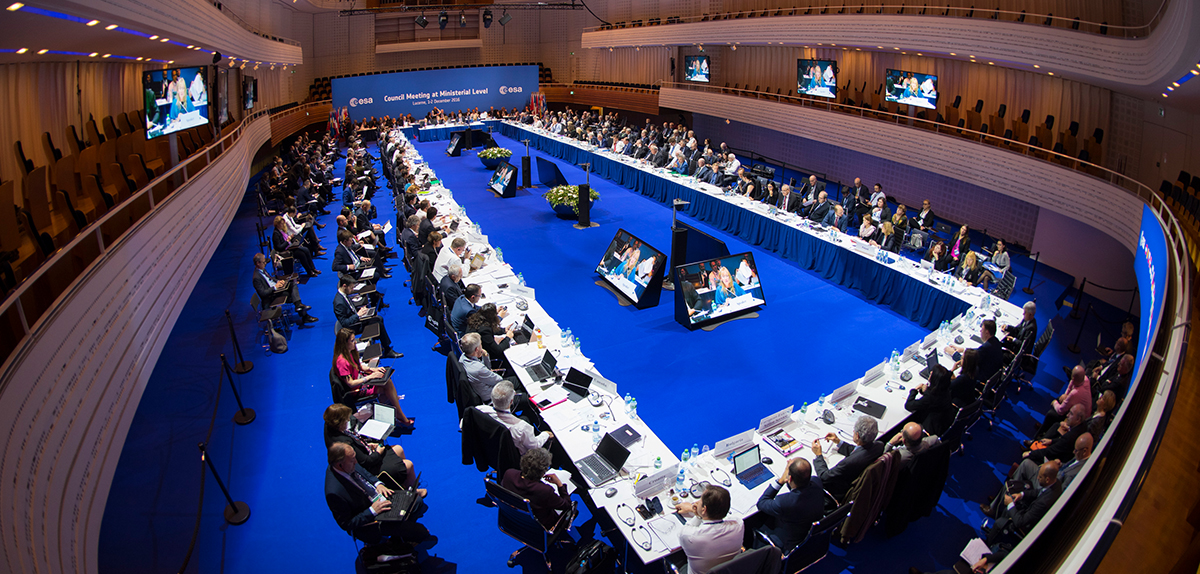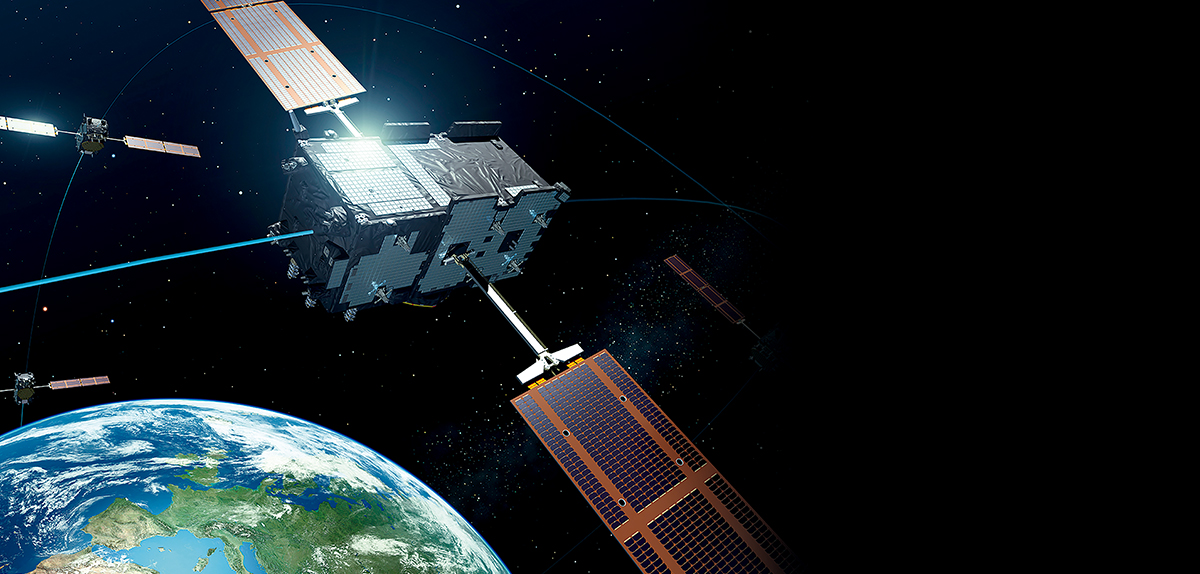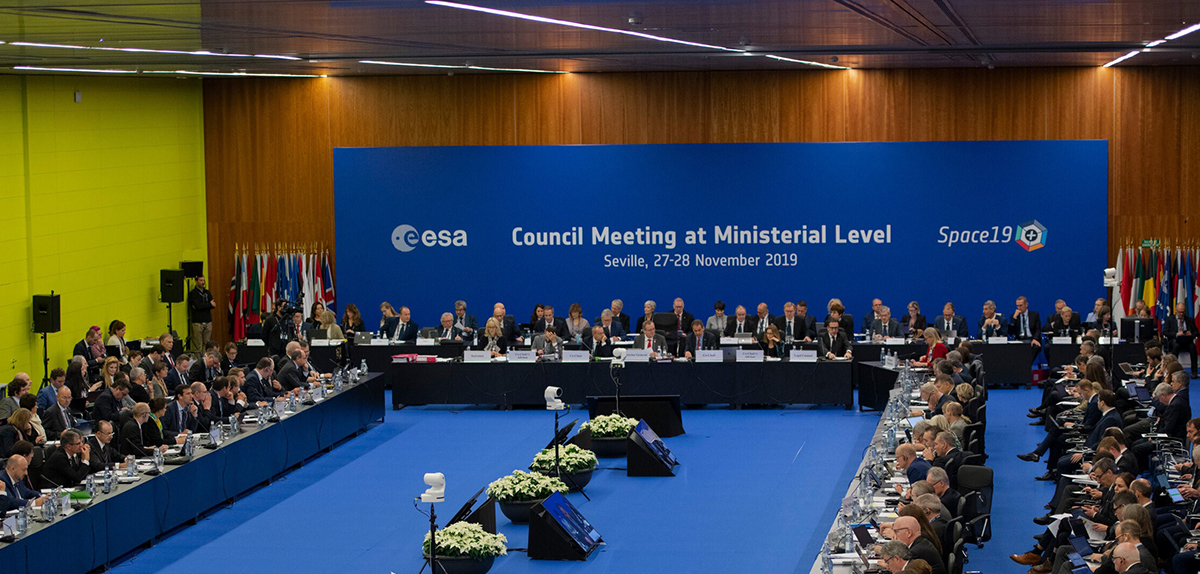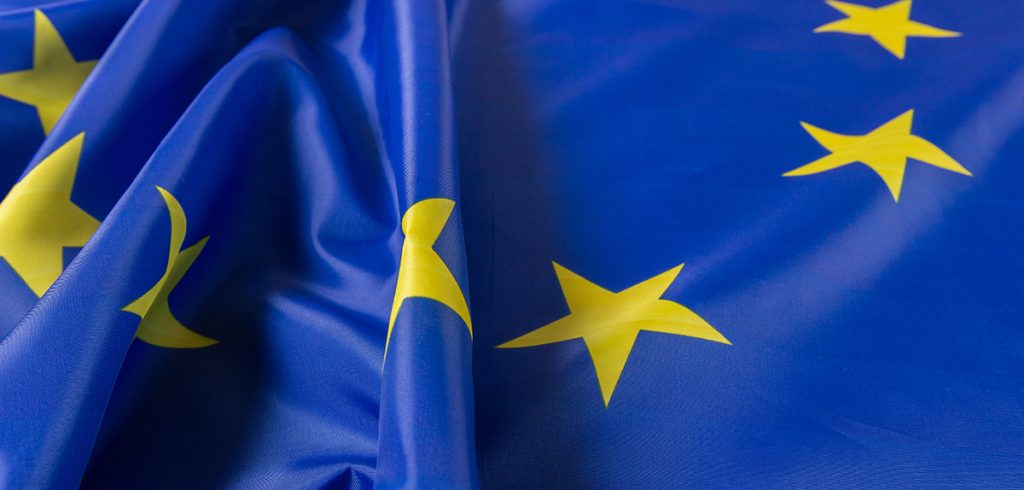Space in Europe is mostly managed under the umbrella of the European Space Agency (ESA). The member states that compose the ESA find in the Agency a shared space where they can capitalize their ambitions in the space sector. In addition, it is the space where all of their efforts are combined toward a greater participation of Europe in the international arena. The Ministerial Councils are where the road that Europe intends to follow in regard to Space is decided, and they are held at the highest levels.
The Council is the governing body of the ESA and it establishes the political guidelines followed by the ESA as it carries out the European space program. Each member state is represented in the Council and has one vote. The ESA is led by a director general, who is elected by the Council every four years.
The ESA Council meets as required and at least twice a year at delegate level and regularly at ministerial level. From time to time, joint and concomitant meetings of the ESA Council and the European Union Council are organized, and are referred to as “Space Council.”
The main goal of the Ministerial Council meetings is to define the role of Space in Europe in regard to key areas of developments and applications. The ministers in charge of the space sector from the 22 ESA Member States and Canada meet every two to three years to put into practice the European Space Policy, commence future programs and make decisions about the next stages of ongoing programs.
Decisions are made in the Council about new proposals and the funding for the upcoming years of work at ESA. The previous ministerial council, ‘Space19+’, was held in November 2019 in Seville (Spain) to define ESA’s vision regarding the future of Europe in space, backing this ambitious plan with record funding. The next one is planned for November 2022, in Paris.
Furthermore, Ministerial Councils are a reflection of a greater ambition, bringing Europe together through Space.
During these macro-meetings, the ambitions for the ‘next generation’ of Europe in Space are defined, and the challenges faced not only by the European space sector, but also but the European society as a whole, are addressed. This proposal includes the director general’s plan for the space programs to be undertaken by the Agency, and it includes all aspects of the space activities: science and exploration, applications, access to Space, operations, research and development. It also puts ESA in a position of world leadership in the emerging field of space safety.
The four great pillars of Space that are subject to analysis and funding are:
Each member state financially supports all the areas that it deems essential for the development of its industry and the interest of its citizens.
The Mandatory Basic Activities are essential for the adequate long-term functioning of the ESA, and in general, they require an increase in resources in line with a greater demand. These include the General Studies Program; the Technology Research Program; the Basic Technical Activities; the Technology Harmonization process; Earthnet, which supports the collaboration with other space agencies and partnerships such as the International Disaster Charter, among others; the Education activities, which include a number of projects for primary and secondary school students; and lastly, the Administrative and Corporate Activities, which are currently being reformed to achieve a higher effectiveness. The technology program is also an ideal environment that fosters the development of existing technologies and the improvement of proprietary products, in addition to technological innovation.
ESA is an intergovernmental organization, while the European Union (EU) is supranational. Both institutions effectively have different competencies, different member states and are governed by different regulations and procedures. However, the EU and ESA share a common goal: strengthening Europe and benefiting its citizens.
While the ESA and the EU are different organizations, they are increasingly working closer together to reach common goals. Due to its execution of EU flagship programs—Galileo and Copernicus—and its support of the EU’s research and development program—Horizon 2020—, approximately 20% of the funds managed by ESA in recent times have been sourced from the European Union’s budget.
During the last few years, the European Union has increased its influence on space applications of interest at a European level.
Galileo is a Global Navigation Satellite System (GNSS) developed by the European Union that provides navigation services: positioning and timing. This program is of great strategic importance for the independence of the European Union, since it avoids the reliance on services such as GPS and GLONASS, the information of which is controlled by third-party countries. From an economic standpoint, this program will imply an investment of 10 billion euros per year and the creation of several highly qualified jobs. The existence of Galileo means having a civilian system owned and controlled by EU institutions.
The European Union is expected to launch a new satellite constellation that aims to provide government and commercial services for the protection of critical infrastructure, and for surveillance and support in external actions and crisis management. The first of these satellites, included within the framework of the Strategic Compass, will be operational by 2024.
The program’s objective is to establish a secure and sovereign space connectivity system for the provision of satellite-based communication services, as well as to bolster the competitiveness of communication services over European satellites.
On June 14, the Council of Ministers approved the project of the Royal Decree for the creation and regulation of the composition and functioning of the Space Council (Consejo del Espacio). This is an inter-ministerial group charged with developing the by-laws and initial plan of action of the future Spanish Space Agency, which will streamline the commissioning of this public body.
Administratively, the Space Council will exist under the wing of the Ministry of Science and Innovation, through the Commissioner for the Aerospace PERTE, and will have representatives from the Cabinet of the President of Government and of the Ministry of the Presidency, Relations with the Cortes and Democratic Memory; Defense; Transportation, Mobility and Urban Agenda; Industry, Commerce and Tourism; Interior; Ecological Transition and the Demographic Challenge; Economic Affairs and Digital Transformation; Agriculture, Fisheries and Food; Finance and Civil Service; Foreign Affairs, European Union and Cooperation and the National Intelligence Center.
It is the first step toward the creation of the future Spanish Space Agency, headquartered in Seville, which will effectively coordinate all activities related to space both in regard to their technological development and to the use of space in fields such as security, Earth observation, geopositioning, communications, etc.
The latest ESA ministerial council was held in November in Paris, and was attended by notable representatives from Spain, such as the minister of Science and Innovation, Diana Morant; the secretary general for Innovation, Teresa Riesgo, and the commissioner for the Aerospace PERTE, Miguel Belló.
The agreements reached as part of this meeting included Spain’s commitment to provide funds for 1.5 billion euros for the 2022-2027 period—the highest amount ever reached by our country. Furthermore, since 2019, the Government has increased its annual share in ESA by 50%, reaching 300 million euros per year. Currently, at 5.5%, Spain is the sixth country with the highest contribution. Overall, ESA Member States have committed to provide funds for 16.9 billion euros—17% higher than in Space19+.
It is clear that the interest generated for studying climate change and secure connectivity in Europe will also be joined by the interest for space exploration.








